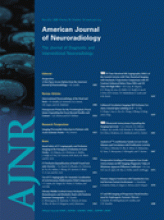We thank Bansal and Derdeyn for their critical review of our manuscript.
First, they have pointed out that the improvement of outcomes in our series,1 when compared with 2 previous reports in 1995 and 1996,2,3 were limited to patients with Hunt and Hess (HH) scale grades IV and V and are at the expense of worse outcomes in patients admitted with HH scale grades I-III. Le Roux et al2,3 reported favorable outcomes (Glasgow Outcome Scores [GOS] 4 and 5) at 6 months after subarachnoid hemorrhage (SAH) in their series of patients treated from 1983 to 1993. GOS 4 and 5 includes patients who have good recovery and patients with moderate disability.4 In our series,1 favorable outcomes (modified Rankin Scale [mRS] scores, 0–2) were measured at 3 months after SAH. mRS 0–2 includes patients who have good recovery and patients who have slight disability.5 Patients with moderate disability (mRS 3) were not considered to have favorable outcomes in our series. The Table gives a comparison between the series from Le Roux et al2,3 and our series after including patients who had moderate disability (mRS 3) at 3 months as patients with favorable outcome.
The outcomes after including mRS 3 as favorable outcomes in our series are comparable with the outcomes of Le Roux et al2,3 in good-grade patients, despite the difference in the timeline at which outcomes were measured in these 2 series. We agree that the improvement in overall outcomes is mainly due to improvement in outcomes of patients with grades IV and V, but this is not at the expense of worse outcome in good-grade patients. It is not possible to compare our results statistically with previously reported series due to variability in instruments used for outcome measures and the time after SAH at which outcomes were measured.
Second, Bansal and Derdeyn have pointed out that our study1 was not designed in a fashion that would allow meaningful comparison of outcomes of patients after clipping or coiling. We agree with them and have acknowledged in the article that this study has limitations because it is retrospective and the pretreatment variables were matched retrospectively by logistic regression analysis. The technique of treatment (clipping or coiling) was not a predictor of the 3-month outcomes after SAH in this group of patients. The main predictor of outcomes was the severity of the hemorrhage (HH scale grade, intracerebral hemorrhage). There were differences between the patients who had clipped and coiled aneurysms in their pretreatment variables (worse hemorrhage grades and more comorbidities in the patients with coiled aneurysms), aneurysm variables (more wide-necked aneurysms in the patients with clipped aneurysms), rebleed rates (1 after clipping and none after coiling), posttreatment secondary insults (more vasospasm in the patients with clipped aneurysms), and discharge destinations (more patients with clipped aneurysms went to rehabilitation, and more patients with coiled aneurysms went home). Logistic regression retrospectively matched the differences in the pretreatment variables (including HH scale grade) between the 2 groups, and there were no significant differences in the 3-month mRS scores between the patients with clipped and coiled aneurysms. This re-emphasizes the fact that in our study, selection of treatment technique did not determine the 3-month mRS score after SAH.
Further outcome studies are being conducted in our institution that analyze patients with grade I and II, grade III and IV, and grade V separately. These studies may allow a more meaningful comparison between these groups. The object of our study was not to show the superiority of 1 technique over another. Because the patients are generally selected for treatment primarily on the basis of aneurysm morphology (dome-to-neck ratio), age, and HH scale grade, parity of outcomes between the 2 groups will confirm the validity of the selection process. If 1 group of patients has distinctly better outcomes than another when the groups are stratified according to the HH scale grade, then our selection process has to be re-evaluated.
Comparison between the series from Le Roux et al and our series after including patients who had moderate disability
- Copyright © American Society of Neuroradiology












